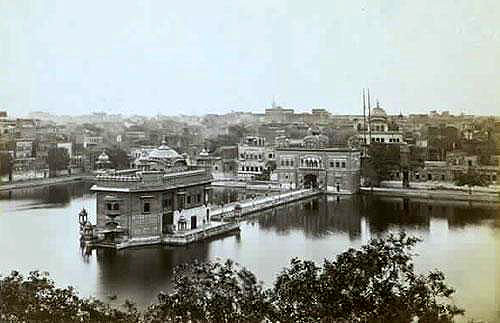|
Sri Harimander
Sahib "Golden Temple", Amritsar (Gurudwaras)
Old Images | Paintings
| Birds EyeView
| DayTime | NightTime
| Inside
Sri Harimandir Sahib Also called Darbar Sahib is known to English-speaking world as the Golden Temple on account of its scenic beauty and the golden coating on its exterior above the first-floor level. It was built under the direction and direct supervision of Guru Arjan Dev ji, who according to current tradition, got it's foundation laid by a well-know Muslim divine, Mir Muhammad, better known as Hazrat Mian Mir of Lahore, on the first of Magh 1645 Bikrami corresponding to 28th December 1588. On completion in about 10 years time, it became the venue for the daily religious services - Kirtan and discourse. When Guru Arjan Dev ji had compiled the compositions of the Gurus including his own and of a numbr of Hindu and Muslim saints into a single volume, now known as the Adi Granth or Guru Granth Sahib, he installed it in the Harimandir on 16th August 1604. Baba Buddha was appointed the first officiant. The routine and liturgy set by Guru Arjan Dev himself is still operative with very little change. Kirtan commences in the Harimandir between 2 am and 3 am depending on the season and continues incessantly, with only ardas or supplicatyory prayer injtervening occasionally, upto 10pm or 11pm. The Holy Book is then taken in procession to a room in the Akal Bunga for rest, and is brought back to the Harimandir again is a procession at about 5 am. the intermission is used for daily cleaning up of the premises. Religious service and significance apart, the architectural design and beauty of the harimandir has its own attraction. Standing in the middle of the pool of Nectar on a plinth of hard stone reached from the bank over a bridge, it provides a rare atmosphere of coolness, calmness and serenity. Its square shape and appropriate dimensions give it perfect geometrical symmetry and compactness. Four doors opening one on each side signify free access from all sides to all irrespective of caste or creed. Of particular interest to common vistiors as well as to connoiseurs of art is the beauty of its interior including intricate floral designs embossed on metal or inset in stone and painting or filiree work on walls and ceiling which are simply enchanting. But the present build and heauty are not wholly original. Harimandir has ha dits share of persecution suffered by the community as a whole. After Guru Hargobind had to leave the town subsequent to the first battle of Amritsar in 1629, no Guru graced the harimandir with his presence. Only Guru Tgegh Bahadur came on a visit in 1664, but he too was not allowed to enter the sanctum sanctorum. Massa Ranghar, the appointed Kotwal of Amritsar after the execution of Bhai Mani Singh in 1737, befouled the sarovar and desecrated the Harimandir. In 1762, Ahmad Shah Abdali had the Harimandir blown up with gunpowder. It was reconstructed by Dal Khalsa through Bhai Des Faj of Sursingh village. The reconstruction was completed by 1776. The present appreance of the Harimandir dates from the reign of Maharaja Ranjit Singh (1801 - 39), although the work of interior decoration continued long after his death. But the Sikh rulers left the religious management with Udasi and Nirmala priests who had been looking after Sikh shrines during the troubled period when baptised Sikh suffered persecution of the creellest kind and were not permitted openly to serve their places of worship. Although Maharaja Ranjit SIngh appointed Giani Sang Singh and, after his death in 1832, his son Bhai Gurmukh Singh as managers yet their responsibility extended only to the beautification of Darbar Sahib. After the annexation of the Punjab by the British in 1849, the practice continued. While the government appointed a sarbarah, the religious administration remained with the mahants and pujaris. Several Malpractices and mismanagement had crept in, which even the Singh Sabha Movement failed to rectify. It was only at the beginning of the Gurdwara Reform (or Akali) Movement (on 15th October 1920) that the harimandir was liberated from the malignant control of the priestly order and brought under panthic management. At present the Harimandir alone with Sri Akal Takht Sahib and other holy shrines in Amritsar are managed directly by the Shiromani Gurdwara Parbandhak Committee under section 85 of the Sikh Gurdwaras Act, 1925. |
